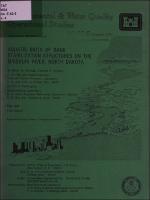Please use this identifier to cite or link to this item:
https://hdl.handle.net/11681/4543Full metadata record
| DC Field | Value | Language |
|---|---|---|
| dc.contributor | National Fishery Research Laboratory (La Crosse, Wis.) | - |
| dc.contributor | United States. Army. Corps of Engineers. Omaha District | - |
| dc.contributor | Environmental and Water Quality Operational Studies (U.S.) | - |
| dc.contributor.author | Burress, Ralph M. | - |
| dc.contributor.author | Krieger, Douglas A. | - |
| dc.contributor.author | Pennington, C. H. | - |
| dc.date.accessioned | 2016-03-16T22:10:01Z | - |
| dc.date.available | 2016-03-16T22:10:01Z | - |
| dc.date.issued | 1982-05 | - |
| dc.identifier.uri | http://hdl.handle.net/11681/4543 | - |
| dc.description | Technical Report | - |
| dc.description | Abstract: Biological and physical data were collected from nine habitats on the Missouri River near Washburn, North Dakota. Sampling was conducted from mid-July to mid-October 1979 to compare the relative values of the habitats for fish and macroinvertebrates. Benthic samples included 11 families, among which oligochaetes (63 percent) and dipterans (34 percent) were numerically dominant. About half of the 166 samples taken at both structured and natural locations contained organisms, but 55 samples taken from mud or mud-fine sand substrates yielded 93 percent of the organisms collected. Although the numbers of taxa per station were not significantly different, there were significant differences in the mean numbers of organisms per station. Densities were greatest at two locations that included extensive areas of backwater (L-head dikes at Location DFH and wing dikes at Location DFW), and least at a revetted location (RVD) where the substrate was largely fine sand. Rock fauna samples included 22 families, with dipterans (nearly 60 percent), trichopterans (33 percent), and oligochaetes (7 percent) comprising all but a fractional percentage of the organisms collected. The average numbers of dipterans, trichopterans, and ephemeropterans tended to increase as current velocities increased to 70 cm/sec, but oligochaetes were most numerous at current speeds of 11 to 30 cm/sec. Maximum density occurred at the stone-faced earth core dike (Location DFE) where the sample contained twice as many families and more than six times as many organisms/m² as were found in the most productive benthic sample (Location DFH). There were statistically significant differences among stations in both the numbers of taxa and organisms/m². Densities were highest at Location DFE, where algal growths on the rocks were heaviest and the average current velocity was highest, and lowest at the hardpoints (Location DFP) where algal growths were sparsest and average current velocity was lowest. Among the 26 species of fish collected, five species comprised nearly two-thirds of the catch. They included carp (18.3 percent), white bass (15.6 percent), white sucker (13.7 percent), yellow perch (10.2 percent), and river carpsucker (7.8 percent). Half of the species collected (13) were represented by fewer than ten specimens. Seven species were found at only two of nine locations, and five others were found at only one location. Of all the habitats sampled, dike fields had the most diverse fish community. There were marked differences in the catch rates by hoop net and seine among the locations, but the differences were not significant. The mean numbers of species of fish taken at different locations by gill nets and electrofishing were different. Differences in the mean number of fish taken per station by gill nets at different locations were different but there was no difference among electrofishing samples. | - |
| dc.publisher | Environmental Laboratory (U.S.) | - |
| dc.publisher | Engineer Research and Development Center (U.S.) | - |
| dc.relation | http://acwc.sdp.sirsi.net/client/en_US/search/asset/1040343 | - |
| dc.rights | Approved for public release; distribution is unlimited. | - |
| dc.source | This Digital Resource was created from scans of the Print Resource | - |
| dc.subject | Aquatic ecology | - |
| dc.subject | Aquatic biology | - |
| dc.subject | Fishes | - |
| dc.subject | Fish | - |
| dc.subject | Invertebrates | - |
| dc.subject | Missouri River | - |
| dc.subject | Sampling | - |
| dc.title | Aquatic biota of bank stabilization structures on the Missouri River, North Dakota | - |
| dc.type | Report | en_US |
| Appears in Collections: | Technical Report | |
Files in This Item:
| File | Description | Size | Format | |
|---|---|---|---|---|
| TR-E-82-6.pdf | 16.07 MB | Adobe PDF |  View/Open |